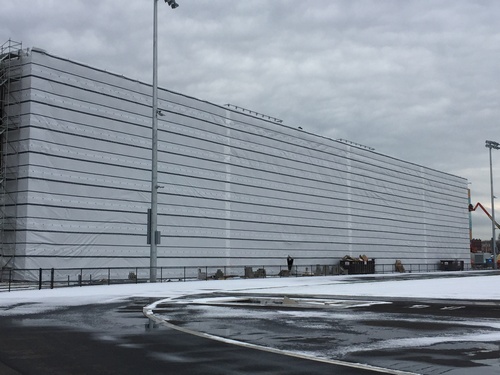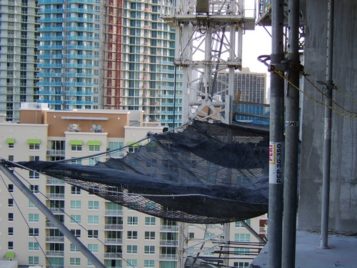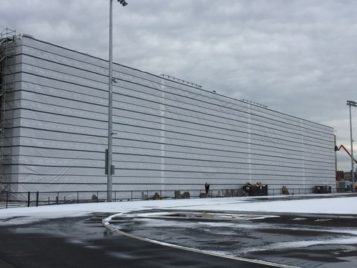
Protecting your jobsite, workers during inclement weather
By Thomas Donahue
Ask any superintendent what their main priority is and they’ll tell you it’s jobsite safety. It’s already a hard job to make sure everyone is working safely but, as the seasons change, the job gets even more difficult thanks to winter weather. Snow and ice seem to complicate construction and can sometimes even slow it down to a standstill. And, so far, this winter season looks like it may be one for the books.
2018 is shaping up to be a big year for bad winter weather. We kicked off the year with an explosive cyclogenesis, also known as the winter “bomb cyclone,” which almost crippled the entire East Coast with equal amounts of frigid cold and heavy snowfall. The streets of Boston, Massachusetts were flooded and frozen over, iguanas in Florida were freezing solid and falling from the trees and 22 people lost their lives. If this first event is the opening act for the rest of winter season, we’re in for a bumpy and cold ride. But the job must go on, whether it’s indoors or out on the jobsite.
OSHA has a section of their website dedicated to the prevention of injuries that winter weather can bring. Dubbed “cold stress,” the webpage defines cold stress and its various forms such as trench foot, frostbite and hypothermia. Also discussed are appropriate solutions, such as staying dry and warm. But how can superintendents do that when they can’t control the weather? There are a few options that can help keep safety going strong during the winter months.
Wrap up the jobsite
According to Jay Kinder, Strong Man Safety Products’ CEO, “Winter weather and jobsites have always been at odds with each other. But, with the right preparation, accidents can be avoided. Some great ways to avoid accidents on the jobsite are with tarps and wraps. People underestimate how much a tarp or wrap can make a difference, but the tarps available on the market today are more advanced and utilitarian than ever before.”
The benefits, Kinder says, is that, “Modern tarps and wraps are built with woven materials such as polyethylene, which holds stronger and lasts for many years. This strength is great at blocking the elements. For example, when installing modern scaffolding wrap tightly, wind chill is reduced. Another benefit is that many modern tarps and wraps are fire retardant, so not only can you block wind, but you can run heaters in work areas. This can drastically cut down on cold stress and other injuries.”
OSHA also states that one of the leading causes of fatalities on the jobsite is through slips and falls. The numbers only seem to rise as winter gets underway. But Kinder believes the right wraps and tarps can be crucial in preventing accidents. “Snow removal tarps do a great job at taking the snow off of your jobsite. You can literally haul the hazardous snow and ice away. This cuts down on the slippery surfaces, but it’s not a foolproof solution,” says Kinder. “If an area looks slippery and could lead to injury or death, well-built safety tarps can catch a crew member and hold them until help arrives. Most modern tarps can hold hundreds of pounds without failure, so having some set up in various locations around the site can save lives.”
Keeping the jobsite safe however doesn’t stop with wraps and tarps. Sickness can run rampant on a jobsite due to outdoor cold weather exposure and the flu is a common occurrence. According to the CDC, the flu causes U.S. workers to lose up to 111 million workdays at an estimated $7 billion a year in sick days and lost productivity. “We’ve all gone to work feeling under the weather, but the best form of safety is prevention in all forms,” says Kinder. “Educating your crew members and teams on the symptoms of the flu, encouraging proper hygiene such as hand-washing and recommending flu shots are great ways to reduce exposure to the flu and other illnesses. A reduction in illnesses not only keeps your crew members healthy, but it also keeps them from making mistakes that can result in accidents and fatalities. When they feel bad, they can’t focus on staying safe. Keeping crews healthy keeps them alert at all times.”
Jobsite safety during the winter months doesn’t have to be tedious—it just takes some planning. Kinder concludes with: “Taking some time to think ahead makes all the difference. A lot of unfortunate events can be avoided by the right precautions. If you plan everything out right, winter will feel just like any other season.”
Winter safety resources
- OSHA’s construction standards and resources: https://www.osha.gov/SLTC/fallprotection/construction.html
- OSHA’s winter preparedness guide: https://www.osha.gov/dts/weather/winter_weather/beprepared.html
- Prevent seasonal flu: https://www.cdc.gov/flu/prevent/index.html
- Construction safety & health: https://www.cdc.gov/niosh/construction/default.html
Thomas Donahue is a copywriter at SFW.




 Join our thriving community of 70,000+ superintendents and trade professionals on LinkedIn!
Join our thriving community of 70,000+ superintendents and trade professionals on LinkedIn! Search our job board for your next opportunity, or post an opening within your company.
Search our job board for your next opportunity, or post an opening within your company. Subscribe to our monthly
Construction Superintendent eNewsletter and stay current.
Subscribe to our monthly
Construction Superintendent eNewsletter and stay current.